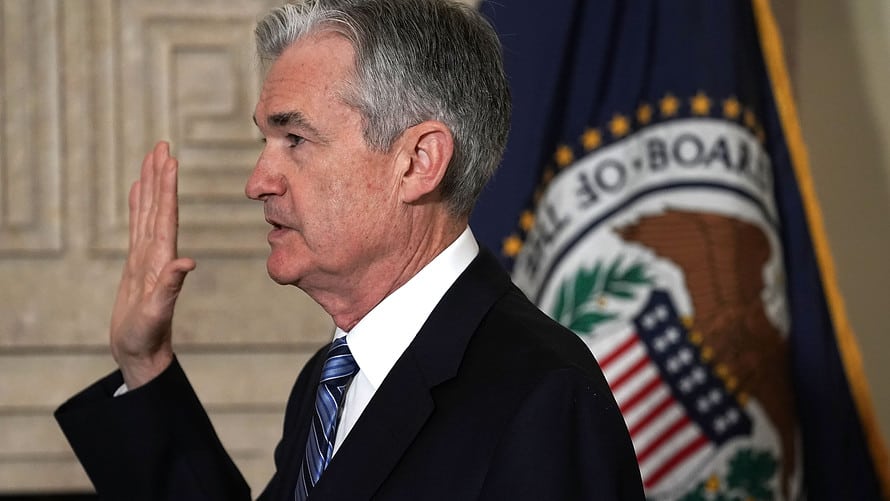

U.S. stock benchmarks ended near session lows Wednesday as the Federal Reserve completed its second increase to benchmark interest rates in 2018, as expected, but signaled a slightly more aggressive plan to tighten monetary policy this year than had previously been projected.
The rate increase also had the effect of narrowing a closely watched gap between rates of two-year and 10-year Treasury notes, which has recently been one of a strong predictor of recessions.
What did markets do?
The S&P 500 SPX, -0.40% fell 11.22 points, or 0.4%, at 2,775.63, with only one of the benchmark’s 11 sectors finishing in positive territory. The consumer-discretionary sector closed 0.1% higher but losses were led by a 0.4% drop in energy and consumer staples. Meanwhile, telecommunications tumbled 4.5%, predominantly on the back of a drop in shares of AT&T Inc. T, -6.20% and Verizon Communications Inc. VZ, -2.89% , but that sector represents just 1.8% of the S&P 500’s total weight.
Meanwhile, the Dow Jones Industrial Average DJIA, -0.47% slumped 119.53 points, or 0.5%, to 25,201.20, dragged to session lows by a decline in Boeing Co. BA, -1.83% and Caterpillar Inc. CAT, -1.77% both closing down by nearly 2%.
The Nasdaq Composite Index COMP, -0.11% meanwhile, shed 8.09 points, or 0.1%, at 7,695.70; the technology-laden benchmark had set an intraday record 7,748.96 before paring those gains.
What’s driving the market?
The Federal Reserve voted to raise its benchmark federal-funds rate by a quarter percentage point to a range of 1.75% to 2%. Eight of 15 Fed officials now expect at least four rate hikes will be needed this year, up from seven at the March meeting.
The Fed’s dot plot, a projection by the members of the central bank’s expectations for rates in the future, shows the policy-setting Federal Open Market Committee penciling in two additional rate increases in 2018 for a total of four increases in the year. That is up from expectations from three in the March Fed rate estimates. The median forecast for the fed-fund rates by the end of the year now stands at 2.4%, compared with the March forecast of 2.1%.
The 10-year U.S. government bond yield TMUBMUSD10Y, -0.25% climbed above a psychological round-number level at 3% before moderating to 2.979%, up 0.02 percentage points, as the short-dated two-year Treasury note TMUBMUSD02Y, -0.15% rose to 2.578%, marking a three-week high. Those moves cut the so-called yield curve to roughly 0.40 percentage points — its narrowest since 2007. Bond prices fall as yields climb.
Wall Street pays attention to the difference between short- and long-dated bonds, typically characterizing the yield curve, because a narrowing differential leading to an inversion of that relationship of debt maturities has been an accurate predictor of economic slowdowns.
In a news conference after the policy decision was released, Chairman Jerome Powell said the Fed was comfortable with a return of once-dormant inflation and emphasized the central bank’s desire to avoid a policy error that could result in unnaturally inflating asset valuations or pushing the economy into a recession. “If you raise rates too quickly you are just increasingly the likelihood of recession,” Powell said.
The Fed chief also indicated that beginning in January, the central bank’s policy updates would be accompanied by a news conference.
On the data front, a measure of wholesale inflation jumped 0.5% in May, against the backdrop of rising oil prices CLN8, -0.02% adding upward pressure on inflation in a steadily growing economy marked by supply bottlenecks and a growing shortage of skilled labor.
In corporate news, AT&T shares tumbled by 6.2%, representing its largest percentage fall since Nov. 5, 2008, following a federal judge’s Tuesday ruling that paved the way for the $85.4 billion merger with Time Warner Inc. TWX, +1.80% . Shares of Time Warner climbed by 1.8%. The deal also helped to deliver a boost to a number of media-related stocks, including shares of 21st Century Fox Inc. FOX, +7.48% and Walt Disney DIS, +1.90% .
What are strategists saying?
“Today’s announcement, including updates to the post-meeting statement and to policymakers’ forecasts for growth, labor markets, inflation, and interest rates, reinforce our expectation that the FOMC will raise the funds rate a total of 4 times in 2018, and additional times in subsequent years,” wrote Ken Matheny, executive director US Economics at IHS Markit:
“The most likely date for the next Fed rate increase is at the September 25-26 FOMC meeting,” he said.
“The headline is that the Fed’s gotten a little more hawkish because the economy has gotten better…It’s not being driven by runway wage inflation,” said Alec Young, FTSE Russell managing director, referring to signs of out-of-control inflation earlier in the year that had helped to send yields climbing and stocks tumbling.
Young said the Fed decision this time was “a validation of the recovery.”